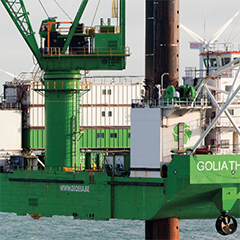The offshore wind market in the U.S. is about to take off and there are enormous growth projections. For the installation of the first wave of U.S. wind parks starting in 2020, European built and operated installation jack-ups will be needed, because currently no U.S. built jack-ups have the capacity to install the turbines. Nor will this type of equipment be built in time in the U.S. PES takes a closer look at the options.
There are plans to build installation jack-ups in the U.S., but it is likely that these will only kick-off after the first wind farms prove to be a success. Aside from this, the infrastructure of the U.S. ports is not suitable for these big vessels, there are bridges and hurricane breakers preventing the jack-up installation vessels to enter or leave the harbors. New hubs and ports will have to be developed before U.S. flagged installation jack-ups will become a practical tool for the installation of the parks.
The problem with using European installation jack-ups, apart from the a fore mentioned infrastructural problems, is the Jones Act. The Jones Act requires vessels transporting merchandise from U.S. point to U.S. point to be U.S. manned, built, flagged and owned. Offshore wind farms are defined as U.S. point and turbine components are defined as merchandise. Consequently, the European installation jack-ups will not be able to transport the turbine parts to the wind parks from U.S. ports. This means a feeder solution is necessary to transport the turbine parts to the jack-ups.
Traditional feeder solutions are small jack-ups or feeder barges. The first Block Island wind park in the U.S. was constructed using small U.S. jack-ups as feeder barges. A normal feeder barge is extremely limited by swell and waves, creating a small operating window and unsafe situations for lift-off. So, finding a suitable supply solution for the U.S. offshore wind market is crucial for the kick-of.
A solution is to use motion compensation for the feedering. A motion compensated platform can be placed on any U.S. flagged vessel or barge, with the wind turbine components on top. After transportation to the Installation jack-up, the motion compensation can be turned on, creating a stable lift-off platform, eliminating the wave motions, increasing the safety and the operating window.
To increase the number of turbine parts to be transported, multiple systems can be used. Either integrated into one system, with a higher capacity, or operating stand alone. They can also be combined with a skidding frame. After one component is safely lifted off the motion compensated platform, the motion compensation can be turned off and the next component can be skidded onto the platform. After the motion compensation is turned on again the operation can be repeated as necessary.
Barge Master launched their motion compensated platform, the BM-T700, in 2013 and the platform has proved the feeder concept works in various supply operations. By compensating the motions of the vessel, the platform effectively turns the deck space into a perfectly stable working area. The BM-T700 creates a stable lift-off base for a maximum weight of 700 tons, in sea states up to heights of 2.5 meters. It is also certified by Lloyds under the lifting appliances rules.




























